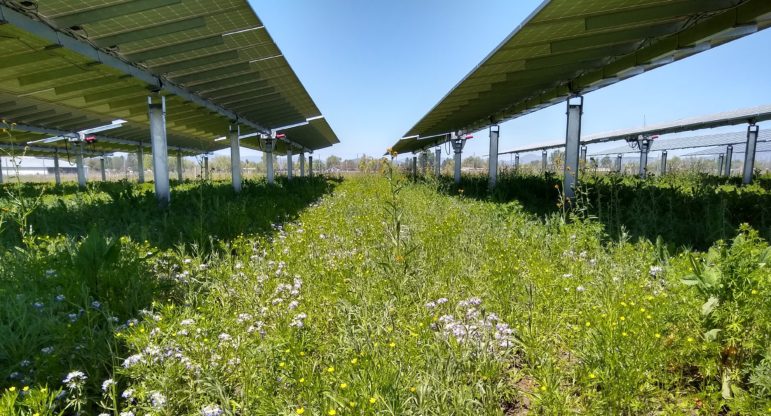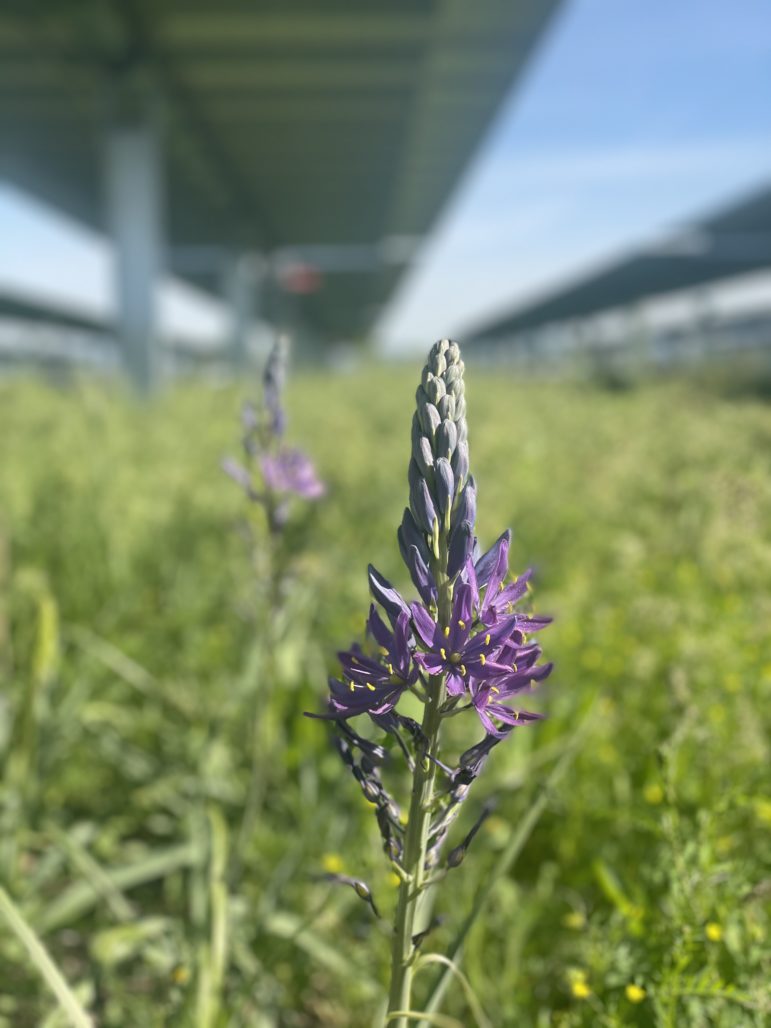
Owner: Pine Gate Renewables
Vegetation: Understory Consulting
Location: Medford, Oregon
Size: 9.9 MW (41 acres, scorecard)
Power Purchaser: PacifiCorp
Completed in late 2017, the 9.9 MW Eagle Point Solar project is located on 41 acres of agricultural land that was previously used for dairy grazing. Research by Oregon State University at the site prompted Science Magazine to describe the project as using practices that “make a planet-friendly energy source even more friendly.”
The developer, Pine Gate Renewables, acquired the project shortly after launching its SolarCulture initiative, which promotes sustainable agriculture, collaboration with communities, and research for intelligent solar development. After determining that experienced landscapers were available to restore and maintain the groundcover, the company decided to make Eagle Point one of the first projects to participate in the new initiative.
Pine Gate hired landscape design consultant Regenerate to come up with a vegetation plan, and Understory Consulting was chosen to develop a multi-year plan to seed the site with native flowers and grasses underneath the tracking photovoltaic (PV) panels in two-portrait configuration.
“For me, it comes from a place of wanting to change the culture of solar and really taking into consideration more than just the panels,” says Pine Gate environmental manager Julianne Wooten.

Understory ecologist Sean Prive says Eagle Point was a unique location ecologically, so he began by making a species list using botanical records from nearby areas with similar soils. From there, he worked with the Bureau of Land Management, sellers in the Portland area, and other partners to acquire the seeds he needed. The mix he created cost $125 per pound, and Understory seeded the entire site using 12 pounds per acre.
Summarizing the research, Oregon State University reports that “researchers found that shade provided by solar panels increased the abundance of flowers under the panels and delayed the timing of their bloom, both findings that could aid the agricultural community.” Following peer review, the research was published in Scientific Reports.
Eagle Point scores 91 points, earning the designation “Provides Exceptional Habitat,” on a pollinator-friendly solar scorecard by UC Davis Wild Energy Lab, Pollinator Partnership, and Fresh Energy. Oregon State University researchers, led by Maggie Graham, collected data on insect and plant populations during a total of seven different two-day visits to the site in 2019.
After the vegetation was completed in 2018, John Jacob—owner and founder of Old Sol Apiaries and president of the Southern Oregon Beekeepers Association—determined that Eagle Point would be an ideal location for his honey bee hives. Pine Gate and Jacob came to an agreement, allowing Jacob to place a few dozen hives on the perimeter of the solar farm. Thanks to the bounty of native and other flowering plants on-site, those hives have become the most productive of Old Sol’s more than 3,000 colonies.

“The bees are kicking butt there,” said Jacob, “It’s a project I’m really passionate about and excited to be part of.” Old Sol’s honey from Eagle Point has been used in the creation of two delicious beers—First Magnitude Brewing’s “Honey Bee Citrus Blonde Ale” being served at Walt Disney World’s International Flower and Garden Festival and Caldera Brewing’s “Let’s Bee Friends” IPA.
While Pine Gate spent more up-front on pollinator-friendly seed, planning, and labor compared to using turf grass, Prive says long-term savings on mowing and maintenance will make the vegetation cheaper over the life of the project. The groundcover at Eagle Point only needs to be mowed about once per year, whereas turf grass can require four or more mows per year. With fuel, equipment, transportation, and labor considered for regularly mowing even a modestly-sized project like Eagle Point (41 acres), the costs add up over the life of the project.
**This case study was written for The Center for Pollinators in Energy at Fresh Energy, a national clearinghouse and catalyzer of pollinator-friendly solar information, standards, best practices, and state-based initiatives. The Center for Pollinators in Energy is a program of Fresh Energy, a clean energy nonprofit in Minnesota working to shape and drive bold policy solutions to achieve equitable carbon-natural economies.**
